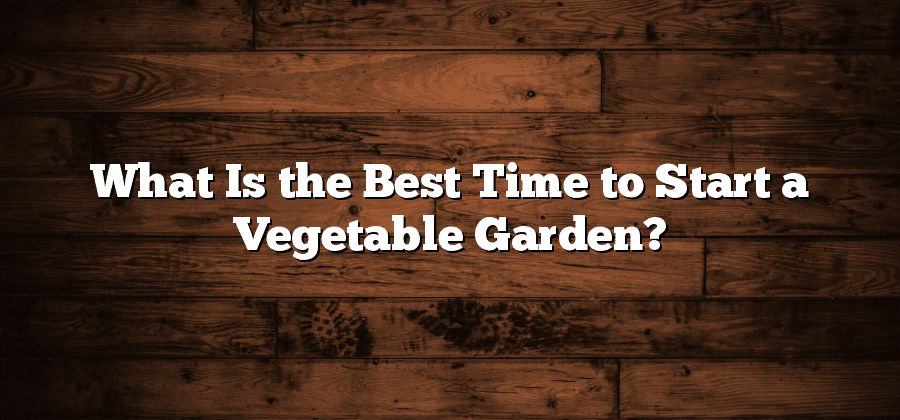Understanding the Climate and Growing Season
The climate and growing season are crucial factors to consider when planning your vegetable garden. Understanding the specific climate conditions in your region will help you choose the right vegetables that thrive in those conditions. By evaluating factors such as temperature, precipitation, and frost dates, you can determine when to start planting and harvesting your crops.
In addition to the climate, it is essential to take the length of the growing season into account. The growing season refers to the period between the last frost in spring and the first frost in fall when the conditions are favorable for plant growth. By knowing the length of your growing season, you can select vegetables that have enough time to reach their full maturity. This knowledge will help you plan which crops to grow and when to plant them for optimal yield.
Assessing Soil Conditions and Preparing the Garden
Soil is the lifeblood of any successful garden. Assessing the soil conditions in your garden is crucial before you begin planting. The first step in this process is to determine the soil texture. Soil texture refers to the relative proportion of sand, silt, and clay in the soil. You can easily assess the soil texture by taking a handful of soil and rubbing it between your fingers. If it feels gritty, it has more sand. If it feels smooth and silky, it has more silt. And if it feels sticky and forms a clump, it has more clay.
Once you have determined the soil texture, the next step is to assess the soil fertility. Soil fertility refers to the ability of the soil to provide essential nutrients for plant growth. You can assess the soil fertility by conducting a soil test. A soil test will measure the pH level of the soil, as well as the levels of macronutrients such as nitrogen, phosphorus, and potassium. Based on the results of the soil test, you can add organic matter or soil amendments to improve the fertility of the soil and create the optimal conditions for your vegetable garden.
Choosing the Right Vegetables for Your Region
It is essential to choose the right vegetables for your region when planning your vegetable garden. Each region has its own unique climate, soil conditions, and growing season, which heavily influence the success of your crops. By selecting vegetables that are well-suited to your specific region, you can maximize your chances of a bountiful harvest.
One important factor to consider is the average temperature of your region. Some vegetables thrive in cooler temperatures, while others require warmer conditions to grow. For example, leafy greens like lettuce and spinach prefer cooler temperatures and will bolt or turn bitter in hot weather. On the other hand, heat-loving vegetables such as tomatoes and peppers require warmer temperatures to develop fruit properly. By taking into account the average temperature range of your region, you can identify which vegetables will experience optimal growth and yield.
Planning and Designing Your Vegetable Garden
When planning and designing your vegetable garden, it is important to consider the available space and layout of your outdoor area. Start by measuring the dimensions of your garden plot and map out the different sections for planting. This will help you determine the amount of space you have and how many vegetables you can grow.
Next, consider the sunlight requirements of the vegetables you wish to grow. Some vegetables thrive in full sun, while others prefer partial shade. Take note of the areas in your garden that receive the most sunlight throughout the day, and allocate those spots for sun-loving vegetables. Additionally, consider the wind patterns in your garden, as some vegetables may need protection from strong gusts.
Once you have determined the space and sunlight availability, you can move on to designing the layout of your vegetable garden. Plan for pathways between the different sections, making sure they are wide enough for easy navigation and maintenance. Consider grouping vegetables with similar water and nutrient needs together, to make watering and fertilizing more efficient.
Lastly, think about incorporating vertical gardening techniques, such as trellises or cages, to maximize the use of space and support climbing vegetables. This can help you grow more vegetables in a smaller footprint and create an aesthetically pleasing design.
Planning and designing your vegetable garden is an exciting step towards a bountiful harvest. By considering the available space, sunlight requirements, and layout, you can create a functional and efficient garden that will enhance your gardening experience.
Starting Seeds Indoors for an Early Start
Starting seeds indoors can give you a head start on the growing season and allow you to enjoy homegrown vegetables earlier. To begin, gather all the necessary materials, such as seedling trays, seed starting mix, and a heat source like a seedling heat mat. Fill the trays with the seed starting mix, making sure it is moist but not waterlogged.
Next, follow the instructions on the seed packets for proper planting depth and spacing. Generally, seeds should be planted at a depth of two to three times their diameter. Place the trays in a warm location, ideally around 70-75 degrees Fahrenheit. To maintain heat and humidity, cover the trays with plastic wrap or a seedling dome.
Keep a close eye on the moisture levels in the soil and make sure it remains consistently moist. Water from the bottom by placing the trays in a shallow tray filled with water, allowing the soil to soak it up through the drainage holes. Once the seedlings start to emerge, it’s essential to provide them with sufficient light. Place them under grow lights or near a sunny window, making sure they receive 12-16 hours of light per day.
By starting your seeds indoors, you can give them the optimum conditions for germination and growth, ensuring a healthy and productive vegetable garden.






